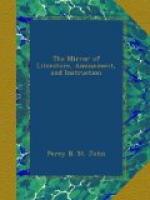DESCRIPTION OF MEKKA.
Mekka maybe styled a handsome town; its streets are in general broader than those of eastern cities; the houses lofty, and built of stone; and the numerous windows that face the streets give them a more lively and European aspect than those of Egypt or Syria, where the houses present but few windows towards the exterior. Mekka (like Djidda) contains many houses three stories high; few at Mekka are white-washed; but the dark grey colour of the stone is much preferable to the glaring white that offends the eye in Djidda. In most towns of the Levant the narrowness of a street contributes to its coolness; and in countries where wheel-carriages are not used, a space that allows two loaded camels to pass each other is deemed sufficient. At Mekka, however, it was necessary to leave the passages wide, for the innumerable visiters who here crowd together; and it is in the houses adapted for the reception of pilgrims and other sojourners, that the windows are so contrived as to command a view of the streets.
The city is open on every side; but the neighbouring mountains, if properly defended, would form a barrier of considerable strength against an enemy. In former times it had three walls to protect its extremities; one was built across the valley, at the street of Mala; another at the quarter of Shebeyka; and the third at the valley opening into the Mesfale. These walls were repaired in A.H. 816 and 828, and in a century after some traces of them still remained.
The only public place in the body of the town is the ample square of the great mosque; no trees or gardens cheer the eye; and the scene is enlivened only during the Hadj by the great number of well stored shops which are found in every quarter. Except four or five large houses belonging to the Sherif, two medreses or colleges (now converted into corn magazines,) and the mosque, with some buildings and schools attached to it, Mekka cannot boast of any public edifices, and in this respect is, perhaps, more deficient than any other eastern city of the same size. Neither khans, for the accommodation of travellers, or for the deposit of merchandize, nor palaces of grandees, nor mosques, which adorn every quarter of other towns in the East, are here to be seen; and we may perhaps attribute this want of splendid buildings to the veneration which its inhabitants entertain for their temple; this prevents them from constructing any edifice which might possibly pretend to rival it.
The houses have windows looking towards the street; of these many project from the wall, and have their frame-work elaborately carved, or gaudily painted. Before them hang blinds made of slight reeds, which exclude flies and gnats while they admit fresh air. Every house has its terrace, the floor of which (composed of a preparation from lime-stone) is built with a slight inclination, so that the rain-water runs off through gutters into the street; for the rains here




